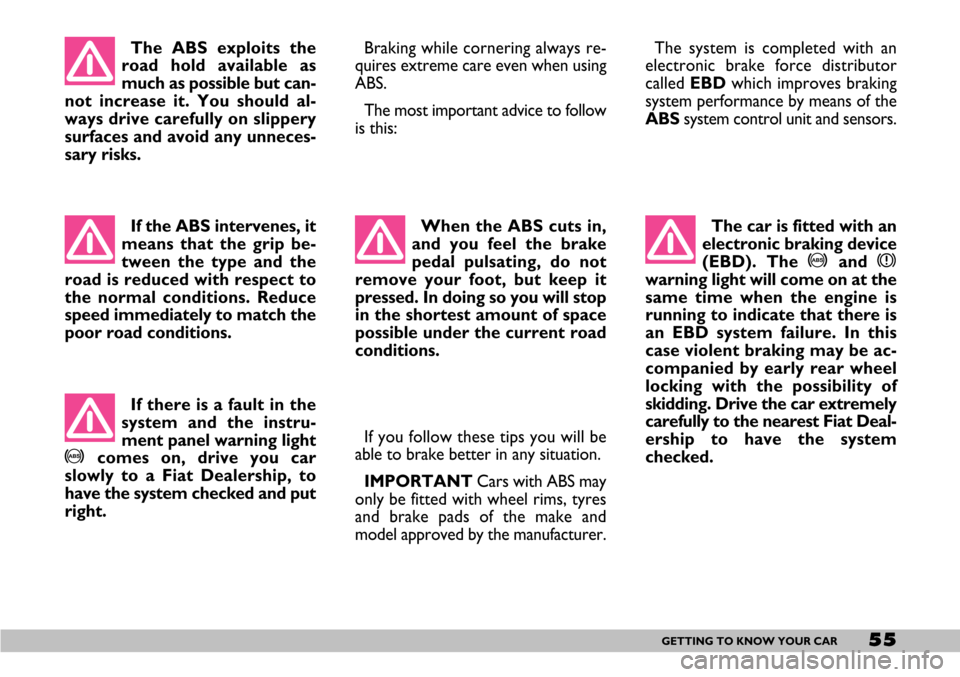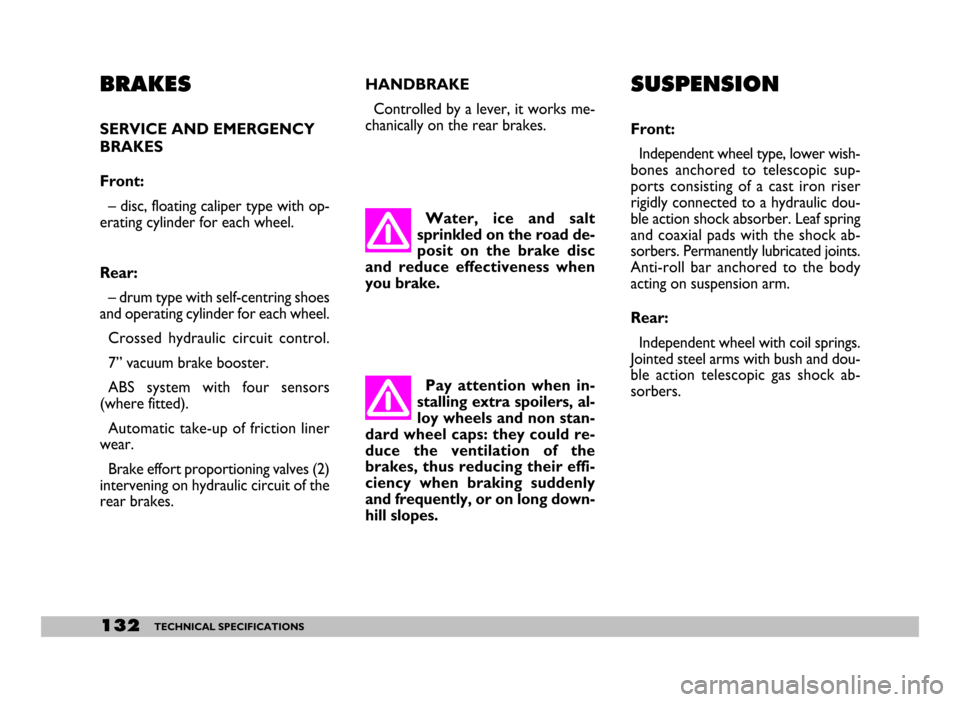brake pads FIAT SEICENTO 2007 1.G Owners Manual
[x] Cancel search | Manufacturer: FIAT, Model Year: 2007, Model line: SEICENTO, Model: FIAT SEICENTO 2007 1.GPages: 154, PDF Size: 3.68 MB
Page 56 of 154

55GETTING TO KNOW YOUR CAR
The ABS exploits the
road hold available as
much as possible but can-
not increase it. You should al-
ways drive carefully on slippery
surfaces and avoid any unneces-
sary risks.Braking while cornering always re-
quires extreme care even when using
ABS.
The most important advice to follow
is this:
If the ABS intervenes, it
means that the grip be-
tween the type and the
road is reduced with respect to
the normal conditions. Reduce
speed immediately to match the
poor road conditions.
If there is a fault in the
system and the instru-
ment panel warning light
>comes on, drive you car
slowly to a Fiat Dealership, to
have the system checked and put
right.When the ABS cuts in,
and you feel the brake
pedal pulsating, do not
remove your foot, but keep it
pressed. In doing so you will stop
in the shortest amount of space
possible under the current road
conditions.
If you follow these tips you will be
able to brake better in any situation.
IMPORTANTCars with ABS may
only be fitted with wheel rims, tyres
and brake pads of the make and
model approved by the manufacturer.The system is completed with an
electronic brake force distributor
called EBD which improves braking
system performance by means of the
ABSsystem control unit and sensors.
The car is fitted with an
electronic braking device
(EBD). The >and x
warning light will come on at the
same time when the engine is
running to indicate that there is
an EBD system failure. In this
case violent braking may be ac-
companied by early rear wheel
locking with the possibility of
skidding. Drive the car extremely
carefully to the nearest Fiat Deal-
ership to have the system
checked.
Page 133 of 154

132TECHNICAL SPECIFICATIONS
BRAKES
SERVICE AND EMERGENCY
BRAKES
Front:
– disc, floating caliper type with op-
erating cylinder for each wheel.
Rear:
– drum type with self-centring shoes
and operating cylinder for each wheel.
Crossed hydraulic circuit control.
7” vacuum brake booster.
ABS system with four sensors
(where fitted).
Automatic take-up of friction liner
wear.
Brake effort proportioning valves (2)
intervening on hydraulic circuit of the
rear brakes. HANDBRAKE
Controlled by a lever, it works me-
chanically on the rear brakes.
SUSPENSION
Front:
Independent wheel type, lower wish-
bones anchored to telescopic sup-
ports consisting of a cast iron riser
rigidly connected to a hydraulic dou-
ble action shock absorber. Leaf spring
and coaxial pads with the shock ab-
sorbers. Permanently lubricated joints.
Anti-roll bar anchored to the body
acting on suspension arm.
Rear:
Independent wheel with coil springs.
Jointed steel arms with bush and dou-
ble action telescopic gas shock ab-
sorbers. Water, ice and salt
sprinkled on the road de-
posit on the brake disc
and reduce effectiveness when
you brake.
Pay attention when in-
stalling extra spoilers, al-
loy wheels and non stan-
dard wheel caps: they could re-
duce the ventilation of the
brakes, thus reducing their effi-
ciency when braking suddenly
and frequently, or on long down-
hill slopes.